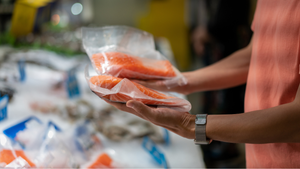Save-A-Lot Could Seek Sale: ReportSave-A-Lot Could Seek Sale: Report
Costly transformation adds to debts. The struggling discounter could sell all or part of itself to address debts amid transformation.

Save-A-Lot may be going back on the block.
The nation’s second-largest hard discounter has engaged investment bank PJ Solomon in seeking strategic alternatives including a potential sale of all or a part of the company, according to a Reuters report. The report, based on confidential sources, said Save-A-Lot’s private owner, Canadian hedge fund Onex Partners, was seeking to address growing debts associated with an ongoing turnaround effort amid intense price competition industrywide and aggressive expansion by discount rivals such as Aldi.
The report said Save-A-Lot would consider other options for reducing its debt if a deal could not be reached.
PJ Solomon declined comment to WGB. Save-A-Lot, based in St. Louis, did not immediately respond to requests for comment.
News of the potential exit comes as Save-A-Lot seeks a turnaround under a new management headed by former Lidl U.S. CEO Kenneth McGrath, who took over following Onex’s $1.4 billion acquisition of the company from Supervalu in 2016. That effort has seen a number of new initiatives to improve operating performance, including chainwide price investments, assortment changes and modernization of the store base. However, sales are expected to decline by about 4% this year and additional borrowings would likely be necessary to fund the turnaround, according to credit service Moody’s.
“The company’s operating performance is expected to remain weak for the next 12 months as management initiatives will take time to gain traction as improvements in revenue and profits will be difficult to achieve in the increasingly competitive hard discount grocery space,” Moody's Senior Credit Officer Mickey Chadha said in a report accompanying a ratings downgrade in November. “We expect operating margins to remain very thin with weak liquidity and credit metrics in the next 12 months.”
Save-A-Lot has a $728 million term loan due in 2023, according to Moody’s. The agency in November downgraded its probability of default rating and corporate family rating to Caa1, which Moody’s defines as “speculative of poor standing and subject to very high credit risk.”
Save-A-Lot operates about 1,230 stores and had 2018 revenues of about $4.1 billion. More than half of its stores are operated by independent licensees.
The company last year introduced a new logo behind a more modern store design and revamped assortment at some stores. A pricing initiative known as the Big Price Drop cut retail prices on hundreds of items, mostly private label, by 10% to 20%. The company has also rolled out programs such as “Wow 6”—weekly deep discounts on fresh products in a manner similar to German hard discounters Aldi and Lidl—and an increased selection of items priced under $1.
Save-A-Lot has also stepped up investment to help corporate and licensed stores remain competitive in markets with heightened price point competition on items such as milk and eggs, sources said.
Although well-positioned to take advantage of the growing discount niche and able to grow cheaply through the partnership model, Save-A-Lot’s performance over the years has been historically unsteady and marked by frequent changes in management and strategy and occasional clashes between corporate management and local owners. This has resulted in varying uniformity between locations, according to a source WGB spoke with who requested to remain anonymous.
“They’ve struggled because they really haven’t been able to achieve the consistent price impression that Aldi has accomplished. It would seem to me that this is a function of the way they are buying and the structure of their [profits and losses]—the ownership may be asking too large a share of the profits,” the source said.
One Save-A-Lot licensee, who asked not to be identified, told WGB that changes in the supply chain under Onex have resulted in varying product quality and availability, and an effort to incentivize uniformity through a national ad program has reduced flexibility for local owners.
Licensees, the source added, were also unhappy that their interests have not been represented on Save-A-Lot’s board of directors.
About the Author
You May Also Like






